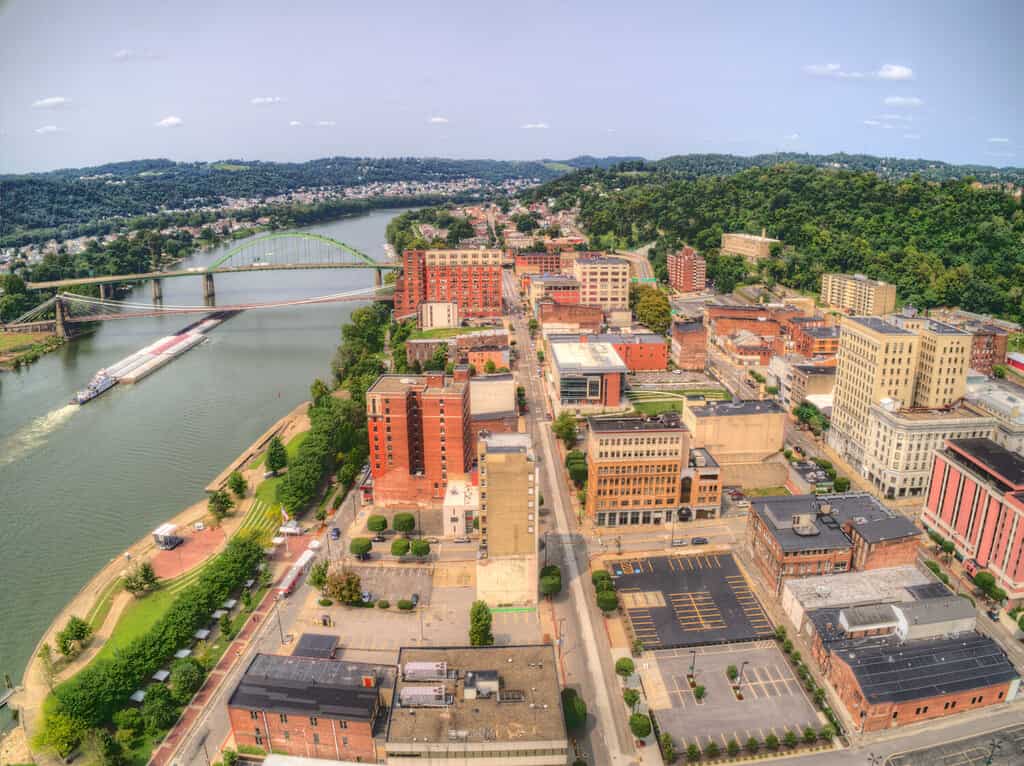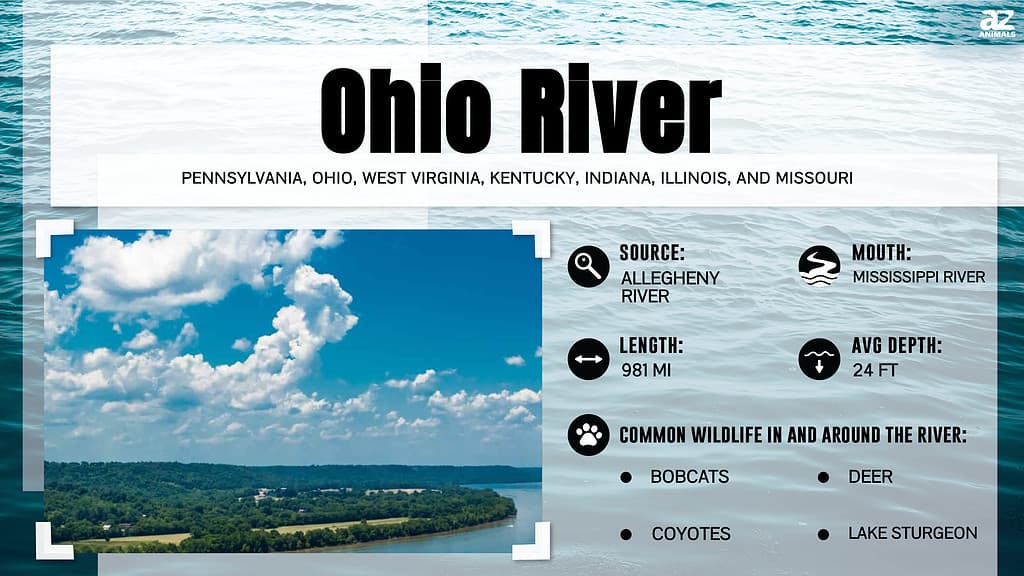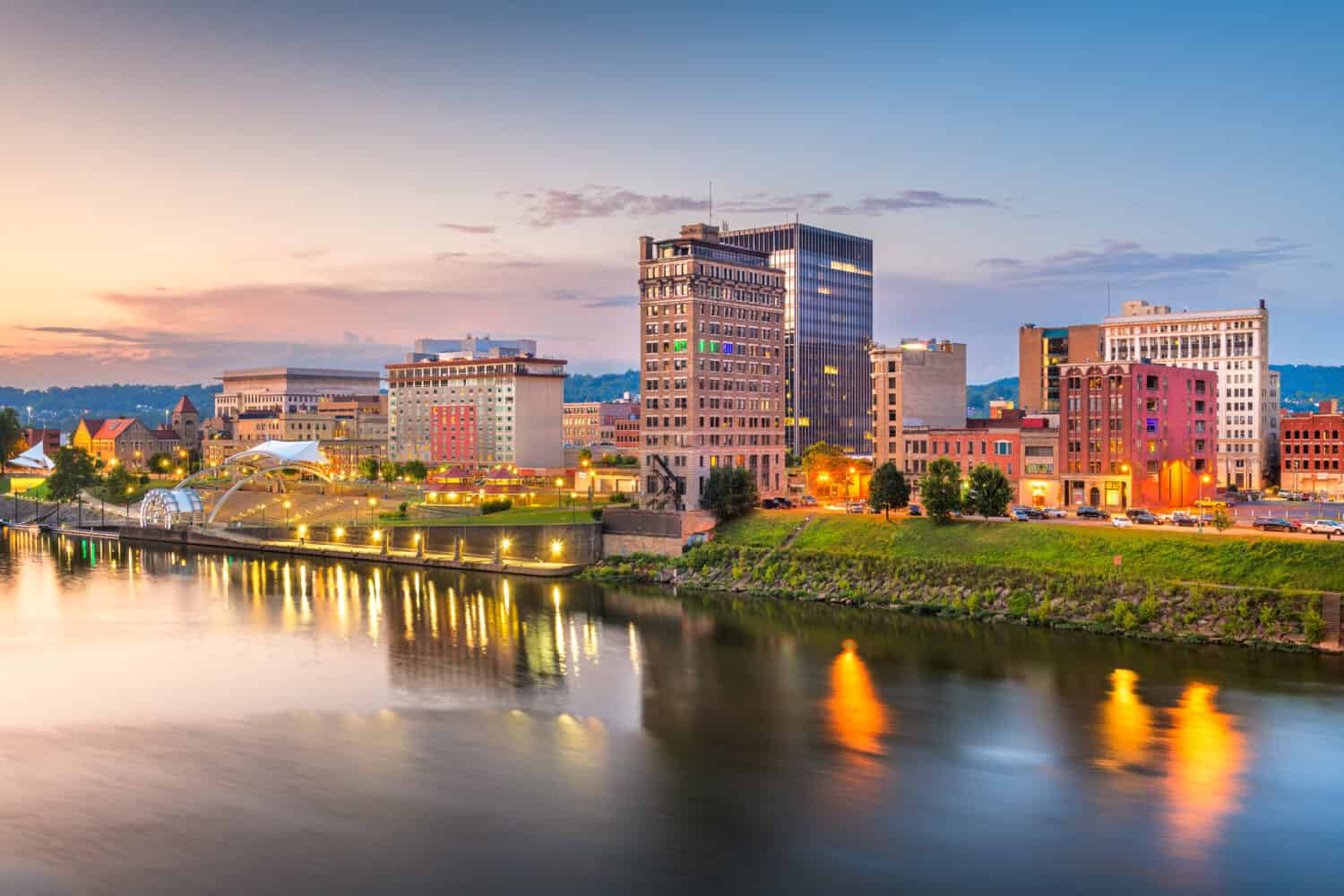West Virginia, often called the “Mountain State”, has natural beauty, rich history, and unique communities. While it may not be the most populous state in the United States, it is home to several cities that play pivotal roles in its culture, economy, and development. Let’s delve into the largest cities in West Virginia, examining their population, total area, and economic impact. Whether you’re a resident or just curious about this scenic state, understanding these cities offers valuable insights into the unique qualities of West Virginia.
Population: The Heart of West Virginia’s Communities

Downtown Wheeling, West Virginia is a bustling center for local activities.
©Jacob Boomsma/Shutterstock.com
Let’s begin by looking at the largest cities in West Virginia by population. These cities have experienced a population decline in recent years. According to the U.S. Census Bureau, the state’s population declined 3.3% between 2010 and 2020. The largest cities in West Virginia face several challenges, including economic downturn and an aging population. However, these cities have many opportunities, including tourism, technology, and healthcare.
Below is a table ranking these cities, along with information about their people, population density, and notable demographic trends:
| Rank | City | Population | Population Density (sq mi) | Notable Demographic Trends |
|---|---|---|---|---|
| 1 | Charleston | 46,536 | 1,701 | Capital city, cultural hub |
| 2 | Huntington | 44,649 | 2,111 | Education and Healthcare Center |
| 3 | Morgantown | 31,073 | 3,222 | Home to West Virginia University |
| 4 | Parkersburg | 29,035 | 1,991 | Industrial and Commerce Center |
| 5 | Wheeling | 26,078 | 2,810 | Historic and tourist attractions |
Total Area: The Geography of West Virginia’s Cities

West Virginia’s picturesque landscapes are an integral part of its identity. The total area of its cities varies greatly, each offering unique geographic features and natural attractions. Morgantown may be relatively small in land area, but it boasts beautiful rolling hills and rivers, making it a favorite destination for outdoor enthusiasts. Charleston stands out with its expansive land area, offering a mix of urban and natural landscapes. Wheeling and Huntington, both along the Ohio River, feature scenic views and recreational opportunities, while Parkersburg is known for its Ohio River frontage and surrounding forests.
Here’s a table ranking the most prominent towns by total land area and some notable aspects of each:
| Rank | City | Total Land Area (sq mi) | Geographic Features | Notable Natural Attractions |
|---|---|---|---|---|
| 1 | Morgantown | 10.63 | Rolling hills, rivers | Coopers Rock State Forest |
| 2 | Charleston | 31.49 | Kanawha River, mountains | Capitol Building, Appalachian Power Park |
| 3 | Wheeling | 15.07 | Ohio River, hills | Oglebay Resort and Conference Center |
| 4 | Huntington | 15.37 | Ohio River, hills | Harris Riverfront Park |
| 5 | Parkersburg | 12.78 | Ohio River, forests | Biennerhassett Island Historical State Park |
Economic Impact: The Engines of West Virginia’s Prosperity
Economic vitality is essential for the growth and development of any city. The largest cities in West Virginia contribute significantly to the state’s economy. Charleston serves as West Virginia’s capital and is a cultural epicenter, hosting numerous festivals and events annually. Its population density reflects its urban character.
On the other hand, Huntington is known for its role in education and healthcare, with Marshall University and several hospitals based in the city, including St. Mary Medical Center. Morgantown is home to West Virginia University and boasts a higher population density, mainly due to its academic influence. Parkersburg is known for its industrial and commercial sectors, while Wheeling stands out for its rich history and tourism appeal.
Here’s a table ranking them by economic output, along with critical industries, significant employers, and noteworthy economic trends:
| Rank | City | GDP (in millions) | Key Industries | Major Employers | Economic Trends |
|---|---|---|---|---|---|
| 1 | Charleston | $15, 728 | Chemical manufacturing, healthcare | Charleston Area Medical Center, DuPont | Diversification and healthcare growth |
| 2 | Morgantown | $8,346 | Education, healthcare, technology | West Virginia University, Mylan | Development in education and technology |
| 3 | Huntington | $7,088 | Education, healthcare, manufacturing | Marshall University, St. Mary’s Med | Education and healthcare investment |
| 4 | Wheeling | $4,496 | Healthcare, tourism, manufacturing | Wheeling Hospital, WesBanco | Tourism and healthcare development |
| 5 | Parkersburg | $3,822 | Chemical manufacturing, healthcare | Camden Clark Medical Cetner, Kraton | Chemical industry and healthcare focus |
Historical Significance

Dents Run Covered Bridge is a historic landmark in West Virginia, constructed in 1889.
©Steve Heap/Shutterstock.com
The largest cities in West Virginia have a rich history dating back to the early days of the state’s founding. Charleston has been the state capital since 1885, and it was a significant center for trade and transportation during the early 20th century. Huntington was founded in 1871 and became an important center for the steel industry in the early 1900s.
Morgantown was founded in 1772 and is home to West Virginia University, established in 1867. Parkersburg was founded in 1789 and was a significant center for the oil and gas industry in the 19th century. Wheeling was founded in 1793 and was a major center for the glass industry in the 19th century.
The Dynamic Diversity of West Virginia
These cities blend geographical features and economic benefits to enhance the state and are essential in shaping West Virginia’s identity and future.
The largest cities in West Virginia can play a pivotal in addressing the state’s challenges. These cities can attract new businesses and jobs to help reverse the population decline. They can also invest in education and healthcare to create a more skilled and healthy workforce. In addition to all of that, they can promote tourism to generate revenue and create jobs. By working together, the largest cities in West Virginia can help to create a brighter future for the state.
Thank you for reading! Have some feedback for us? Contact the AZ Animals editorial team.








